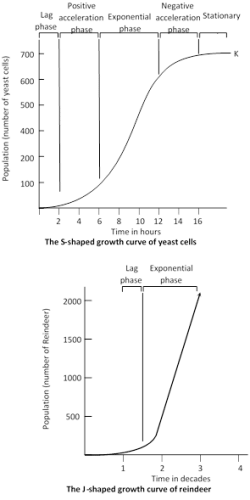NEET Exam > NEET Questions > Human population follows thea)J-shaped growth...
Start Learning for Free
Human population follows the
- a)J-shaped growth curve
- b)Z-shaped growth curve
- c)S-shaped growth curve
- d)All of the above
Correct answer is option 'C'. Can you explain this answer?
Verified Answer
Human population follows thea)J-shaped growth curveb)Z-shaped growth c...
Logarithmic or Exponential phase : It is characterized by rapid growth in population which continues till enough food is available. But with the increase in reindeer population, there is corresponding decrease in the availability of food and space, which finally become exhausted, which leads to mass starvation and mortality. This sudden increase in mortality is called population crash. Lemming of Tundra, some insect, algal blooms and annual plants also show J-shaped curves. The population growth curve is S- shaped in most of the organisms, Human population also shows S-shaped curve.

View all questions of this test

Most Upvoted Answer
Human population follows thea)J-shaped growth curveb)Z-shaped growth c...
Human population follows an S-shaped growth curve.
Explanation:
The growth curve of human population can be described by an S-shaped curve, also known as the logistic growth curve. This curve represents the pattern of population growth over time, showing how the population size changes in relation to the available resources and environmental conditions.
Initial Slow Growth:
The S-shaped growth curve starts with a period of slow growth, where the population size increases gradually. During this phase, the population is still small and the resources are abundant, allowing for a relatively low growth rate.
Accelerated Growth:
As the population size increases, the growth rate starts to accelerate. This is the second phase of the S-shaped curve, where the population experiences exponential growth. The rate of population increase becomes faster as more individuals are added to the population, leading to a rapid rise in population size.
Stable Growth:
However, as the population approaches its carrying capacity, the growth rate begins to slow down. This is the third phase of the S-shaped curve, where the population growth stabilizes. The population reaches a point where the available resources and environmental conditions can only support a certain number of individuals. As a result, the growth rate decreases and the population size becomes relatively stable.
Interpretation:
The S-shaped growth curve reflects the concept of population regulation, where a population naturally adjusts its growth in response to the available resources and environmental limitations. The curve shows that population growth is not indefinite, but rather reaches a point of equilibrium where the population size remains relatively constant.
Conclusion:
In summary, the human population follows an S-shaped growth curve, starting with slow growth, followed by accelerated growth, and eventually stabilizing at a certain population size. This pattern of growth is influenced by factors such as resource availability, environmental conditions, and population regulation mechanisms.
Free Test
FREE
| Start Free Test |
Community Answer
Human population follows thea)J-shaped growth curveb)Z-shaped growth c...
Human population follow sigmoid shape curve

|
Explore Courses for NEET exam
|

|
Question Description
Human population follows thea)J-shaped growth curveb)Z-shaped growth curvec)S-shaped growth curved)All of the aboveCorrect answer is option 'C'. Can you explain this answer? for NEET 2025 is part of NEET preparation. The Question and answers have been prepared according to the NEET exam syllabus. Information about Human population follows thea)J-shaped growth curveb)Z-shaped growth curvec)S-shaped growth curved)All of the aboveCorrect answer is option 'C'. Can you explain this answer? covers all topics & solutions for NEET 2025 Exam. Find important definitions, questions, meanings, examples, exercises and tests below for Human population follows thea)J-shaped growth curveb)Z-shaped growth curvec)S-shaped growth curved)All of the aboveCorrect answer is option 'C'. Can you explain this answer?.
Human population follows thea)J-shaped growth curveb)Z-shaped growth curvec)S-shaped growth curved)All of the aboveCorrect answer is option 'C'. Can you explain this answer? for NEET 2025 is part of NEET preparation. The Question and answers have been prepared according to the NEET exam syllabus. Information about Human population follows thea)J-shaped growth curveb)Z-shaped growth curvec)S-shaped growth curved)All of the aboveCorrect answer is option 'C'. Can you explain this answer? covers all topics & solutions for NEET 2025 Exam. Find important definitions, questions, meanings, examples, exercises and tests below for Human population follows thea)J-shaped growth curveb)Z-shaped growth curvec)S-shaped growth curved)All of the aboveCorrect answer is option 'C'. Can you explain this answer?.
Solutions for Human population follows thea)J-shaped growth curveb)Z-shaped growth curvec)S-shaped growth curved)All of the aboveCorrect answer is option 'C'. Can you explain this answer? in English & in Hindi are available as part of our courses for NEET.
Download more important topics, notes, lectures and mock test series for NEET Exam by signing up for free.
Here you can find the meaning of Human population follows thea)J-shaped growth curveb)Z-shaped growth curvec)S-shaped growth curved)All of the aboveCorrect answer is option 'C'. Can you explain this answer? defined & explained in the simplest way possible. Besides giving the explanation of
Human population follows thea)J-shaped growth curveb)Z-shaped growth curvec)S-shaped growth curved)All of the aboveCorrect answer is option 'C'. Can you explain this answer?, a detailed solution for Human population follows thea)J-shaped growth curveb)Z-shaped growth curvec)S-shaped growth curved)All of the aboveCorrect answer is option 'C'. Can you explain this answer? has been provided alongside types of Human population follows thea)J-shaped growth curveb)Z-shaped growth curvec)S-shaped growth curved)All of the aboveCorrect answer is option 'C'. Can you explain this answer? theory, EduRev gives you an
ample number of questions to practice Human population follows thea)J-shaped growth curveb)Z-shaped growth curvec)S-shaped growth curved)All of the aboveCorrect answer is option 'C'. Can you explain this answer? tests, examples and also practice NEET tests.

|
Explore Courses for NEET exam
|

|
Signup for Free!
Signup to see your scores go up within 7 days! Learn & Practice with 1000+ FREE Notes, Videos & Tests.


















